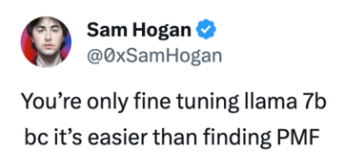Why LLM Fine-Tuning isn't Always a Good Idea
LLM fine-tuning sounds exciting and easy. But the actual costs associated with LLM fine-tuning can often far outweigh the benefits.

Summary
Large Language Model fine tuning – or LLM fine-tuning – is a tantalizing prospect for many generative AI practitioners. While the endeavor promises improvements like precise responses and reduced hallucinations, the actual costs of this endeavor can often outweigh the benefits. There are also alternate solutions in the market, like Gleen AI, that offer superior results without the pitfalls of fine-tuning.
What is an LLM?
LLMs are a complex machine learning models that can understand and generate human-like responses. These models can answer questions, compose text, or assist with various tasks, like improving customer service or assisting agents with creating initial drafts of responses to customer questions.
What is LLM Fine-Tuning?
Fine-tuning an LLM involves further training an existing LLM.
A pre-trained LLM trains on massive amounts of data from the internet. Fine-tuning an LLM means training an existing LLM on a very specific dataset.
The intent of fine-tuning is to make the LLM more adapted or specialized to a particular task or domain. It refines the LLM's performance by leveraging its general knowledge while concentrating on the nuances of the new data.
For example, a law firm could potentially fine-tune an LLM with a database of legal contracts and a glossary of legal terms. A pharmaceutical company could potentially fine-tune an LLM with all the brand names of its drugs, active ingredients, contra-indications, and warnings.
How to Fine Tune an LLM
Define Your Task and Collect Data
- Determine the specific task: sentiment analysis, question answering, translation, etc.
- Gather a labeled dataset pertinent to this task. The quality and quantity of this data play a crucial role in the success of fine-tuning.
Choose a Pre-trained Model
- Start with a general pre-trained LLM that aligns with your task's requirements.
- Platforms like Hugging Face offer a multitude of pre-trained models suitable for various tasks.
Set Up the Training Environment
- Ensure you have the necessary computing resources, typically a GPU or TPU for efficient training.
- Use frameworks like TensorFlow or PyTorch which have built-in support for LLMs.
Prepare the Data
- Tokenize your data using the same tokenizer you used for the pre-trained model.
- Split the data into training, validation, and test sets. Ensure that the data distribution is consistent across these splits.
Fine-Tuning Configuration
- Learning Rate: Choose a smaller learning rate than what you'd typically use for training from scratch. This ensures that the model doesn't deviate drastically from its pre-trained state.
- Epochs: Since you're fine-tuning and not training from scratch, fewer epochs might suffice.
- Batch Size: Balance between computing efficiency and gradient accuracy. Larger batches provide more stable gradients but demand more memory.
Training
- Use the training set to fine-tune the model. Regularly evaluate the model on the validation set to monitor overfitting.
- Consider using techniques like early stopping if the validation performance starts degrading.
Evaluation and Iteration
- After training, evaluate the model on the test set.
- If the performance isn't satisfactory, consider collecting more data, adjusting hyperparameters, or trying different pre-trained models.
Deployment
- Once you achieve desired results, deploy the fine-tuned model to serve your specific application.
The Perceived Benefits of LLM Fine-Tuning
Many start-ups and enterprises have recently embarked on fine-tuning existing LLMs.
There are 4 key perceived benefits behind the push to fine-tune an LLM. They are:
- Task Specificity: Pre-trained LLMs are trained on vast datasets. While this general training gives them extensive language capabilities, they may not always be good at very specific tasks. Fine-tuning refines the model to perform better on specific tasks.
- Domain Adaptation: If the target domain differs significantly from the LLM's general training data, the model may exhibit suboptimal performance. Fine-tuning can help in adapting the model to nuances of a specific domain. For example, companies in the legal, medical, biotech, or pharma sectors might benefit more from fine-tuning an LLM.
- Efficiency: Fine-tuning is probably cheaper and faster than building an LLM from scratch. Taking an existing LLM and tweaking pre-trained weights could potentially save substantial time and resources.
- Eliminate Hallucination: Fine-tuning might reduce the LLM's propensity to produce statements that are misleading or outright incorrect -- i.e., hallucinate.
However, just because you can fine-tune an LLM doesn't mean you should fine-tune an LLM. Or, as one person on Twitter posted:

The Actual Costs Associated with LLM Fine-Tuning
Fine-tuning an LLM comes with several unavoidable costs:
- You need to buy or rent a lot of GPUs: Fine tuning an LLM requires a lot of GPUs. Buying or renting more GPUs accelerates the fine-tuning process.
- It takes considerable time to fine-tune an LLM: Fine-tuning an LLM is not an overnight process. It can be very involved and prolonged.
- You need to hire ML Ops personnel: Ensuring that the LLM runs effectively post-tuning requires expertise and hands-on management.
Potential Risks of LLM Fine-Tuning
In addition to the hard costs, fine-tuning an LLM has potential risks:
- A fine-tuned LLM will still hallucinate: Even fine-tuned LLMs still produce incorrect or made-up information (i.e., hallucinate).
- Poor responses: Even if you fine-tune an LLM, your results might not be as good as GPT-3.5. There's really no guarantee of surpassing the performance of pre-established models.
- Losing content safeguards: A study recently highlighted in VentureBeat indicates that fine-tuning LLMs can compromise content safeguards built into LLMs. Read the Venture Beat article here.
What's an Alternative to Fine-Tuning an LLM?
LLM fine tuning can be a long, expensive, and potentially risky endeavor. For many companies, the ROI of fine-tuning might not make sense.
Instead of fine-tuning an LLM, companies should consider commercial AI chatbot like Gleen AI.
- Gleen AI works with any LLM, including GPT-4, Llama2, or Claude. If you use Gleen AI with Llama2 or Claude, Gleen will help with fine-tuning.
- Proprietary Knowledge: You can train Gleen AI on your entire proprietary knowledge base.
- Gleen AI provides highly relevant answers. Gleen AI combines the power of an LLM with a company's specific knowledge to yield highly relevant responses.
- Gleen AI doesn't hallucinate. 80% of Gleen's technology stack focuses on preventing hallucination.
Watch it now: Gleen AI vs. a GPT trained on the same knowledge. The GPT hallucinates, but Gleen AI doesn't.
Conclusion
Fine-tuning an LLM is indeed an available option for companies venturing into AI solutions.
With the costs, time, and uncertainties involved, sometimes turning to generative AI SaaS solutions like Gleen AI is more pragmatic. These platforms can offer quicker, more reliable results with a superior return on investment.
Try Gleen AI. Create your own free, custom generative AI chatbot with Gleen AI now or request a demo of Gleen AI.



